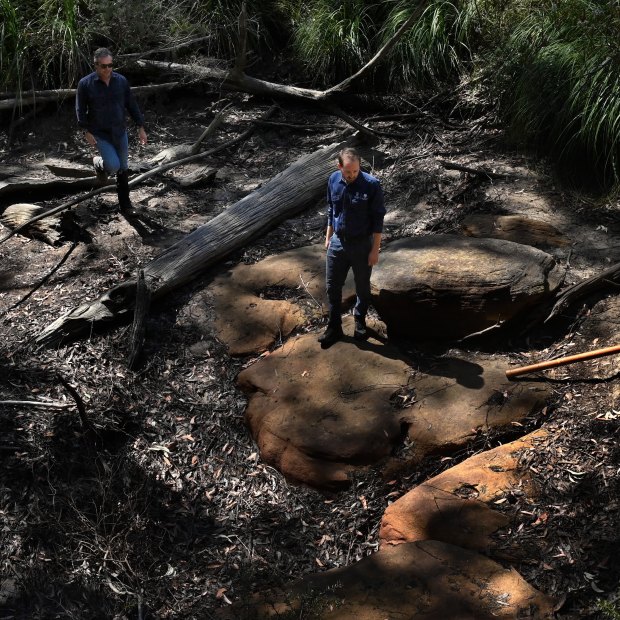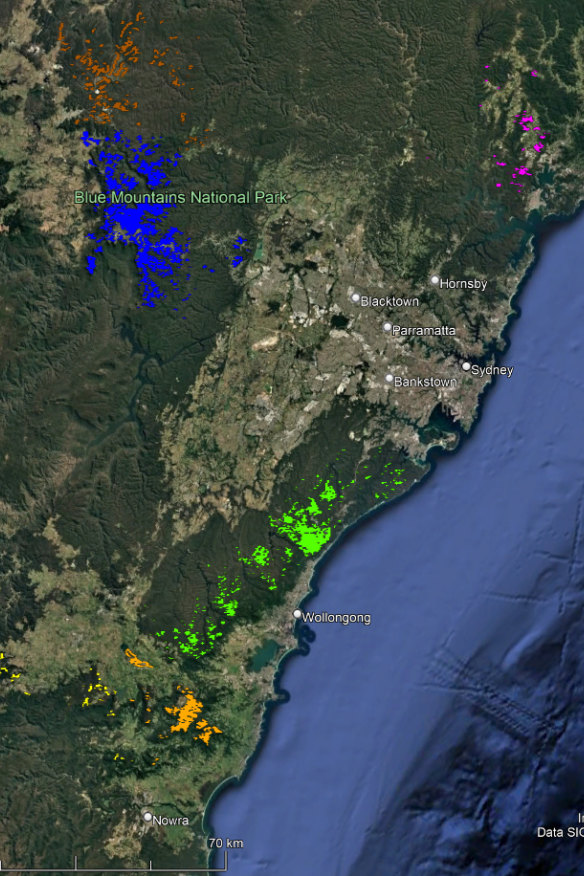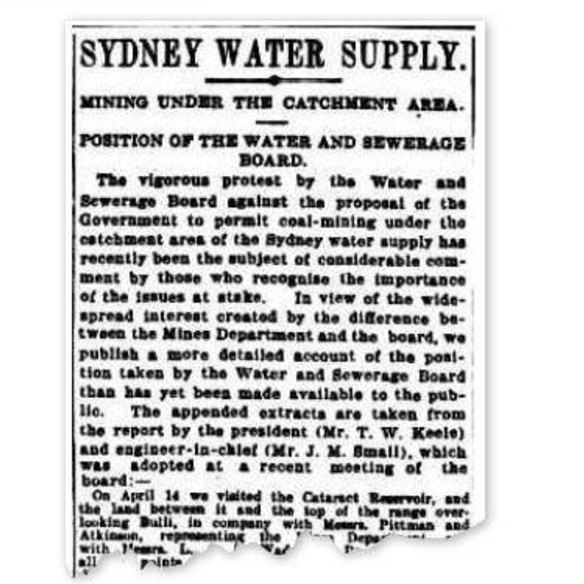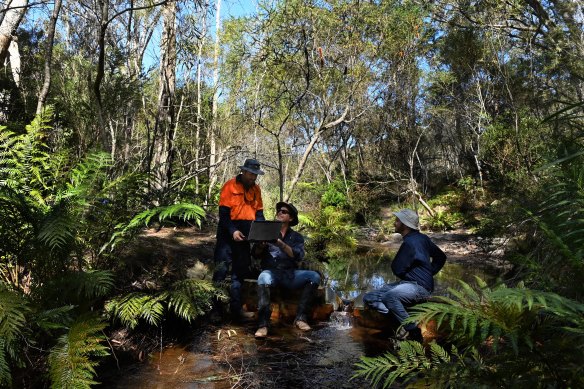Once healthy creeks in the Sydney catchment have become dead zones. Now scientists know why

UNSW Professor William Glamore (left) and PhD candidate Joe Cairns at the bottom of a dried-up waterfall and pond under Swamp 14.Credit: Kate Geraghty
From the moment you walk into Swamp 14 in the water catchment south of Sydney, it is clear that something is wrong.
Where the ground should feel springy and spongy underfoot, it is dry and crunchy instead.
In the area of densest vegetation, where it should be wettest, thickets of ferns are dying off from lack of water. Where there was once a creek and waterfall, there is nothing but bare rock.
The site had been monitored since 2015 and was healthy in July 2020. It was literally undermined in August 2020, when a 305-metre wide longwall for coal mining was tunnelled underneath for almost two kilometres.
By the following month, the swamp had fully drained. But for occasional bouts of heavy rain, it has been a dead zone ever since.
Scientists say it cannot be restored. One more coastal upland swamp – supposedly protected as an endangered ecological community – has been lost forever.
This is the legacy of coal mining in the water catchment. Groundbreaking research by the University of NSW and WaterNSW has finally provided conclusive evidence of the effects.
“Previously there was always debate about the impacts and the debate never progressed because of the lack of science,” says UNSW Professor William Glamore.
The implications are huge because draining the swamps also threatens the quality of Sydney’s drinking water and heightens the risk of bushfires in dry peat.
Longwall mining is a mechanised form of underground mining in which an entire seam of coal is cut out in a single slice using high-powered cutting machines and conveyors to move the coal out of the mine.
The problem with the technique, Glamore says, is it creates a void that leads to subsidence. Once there are cracks, water will drain away.
“It’s like a Jenga effect,” Glamore says. “You pull out enough blocks and, all of a sudden, the whole tower collapses.”
The peer-reviewed research supervised by Glamore, the principal research fellow at the Water Research Laboratory, and led by PhD candidate Joe Cairns was published in August in Journal of Hydrology. The team measured groundwater, the flow of water, rainfall and other weather at several sites over several years. They found swamps drained rapidly once undermined.
The Sun-Herald was given rare access to the water catchment to view and document the damage. On a fine September day, we visited the Woronora Plateau west of Wollongong near Cordeaux dam, accompanied by Glamore, Cairns and staff from WaterNSW.
Upland swamps are small pockets of wetlands that feed the headwaters of creeks. In NSW, they provide habitat for creatures such as the endangered giant dragonfly and the vulnerable Littlejohn’s tree frog.
“It’s like a Jenga effect.”
UNSW Professor William Glamore
Coastal upland swamps in the Sydney basin are listed as endangered. The main locations are Woronora, the Blue Mountains and Newnes near Lithgow. But many have already been undermined and destroyed, Glamore says, and restoration is impossible.
“I’d have to literally move the entire wetland off to the side, find the cracks, fill the cracks somehow, and then try to bring the wetlands back,” he says. “That’s never going to happen.”
Western Sydney University water scientist Ian Wright describes the work of the UNSW team as “fantastic”. He has done similar research outside the water catchment, and seen the “sad and pathetic” results of attempts to restore a creek affected by mining near Picton.
It is possible to see the cracks in a creek bed, but as Wright says, “trying to glue it up is as futile as the king’s horses and men trying to put Humpty Dumpty together again”.
Mining companies are largely focused on offsets. In the case of the Dendrobium mine affecting Swamp 14 and other upland swamps on the Woronora plateau, the mining company has transferred the 598-hectare Maddens Plains site just north of Wollongong to the NSW government for inclusion in the national park as a wildlife corridor.
Glamore says this is absurd because upland swamps are supposed to be protected.

Coastal upland swamps and temperate highland peat swamps on sandstone in NSW: Woronora (green), Blue Mountains (blue), Newnes (brown), Budderoo (orange), Gosford (pink), and Penrose (yellow).Credit: Fryirs and Hose
“We need to have a program that says, if we can’t protect what’s there, we shouldn’t impact it,” Glamore says. “There is currently no way of fixing them. They don’t regenerate on their own. They won’t seal on their own, and we’re leaving the future generations much worse off for a very short term potential gain.”
‘Death by a thousand cuts’
Glamore will have another PhD student test for any changes to water chemistry downstream from Swamp 14, and he expects to see an increase in iron. The resultant red staining is evident in other waterways in the area near affected swamps.
The impact on the quality of drinking water is “death by a thousand cuts”, Glamore says.
The Metropolitan Special Area covers 90,239 hectares and protects the catchments of Cataract, Cordeaux, Avon and Nepean dams, which together supply a fifth of Sydney’s drinking water. Wright says this is “Sydney’s best water” and mining is having an “adverse impact”.

Mining in the Sydney water catchment has been contentious since 1904.Credit: The Sydney Morning Herald
The coal in the Illawarra escarpment is metallurgical coal – the kind used in steelmaking rather than power generation, so it will not be phased out as part of the energy transition. Wright says he understands mining in the Illawarra provides jobs and community benefits, but there are less sensitive areas to mine.
“If we just leave them alone, and look after the protected bushland around those [dams], they’re going to keep providing water sustainably for hundreds of years,” Wright says.
“You take that pass of coal with a longwall, that’s good for a few months, a few jobs, some dollars, but you’ve just degraded that beautiful, sustainable water supply.”
From carbon sink to carbon source
Another serious risk is fire. Wright says the upland swamps contain about three to five metres of waterlogged peat, an “accumulation of rotted vegetation, almost like preserved, condensed carbon”.
“When it dries out, peat burns extremely well, as a lot of people from Ireland and the United Kingdom know,” Wright says. “It’s taken 10,000 to 15,000 years to build up, and it’s gone forever.”
Glamore says peat can burn or smoulder for days, so the swamp switches from being a carbon sink to a carbon source.
If the bushfire is followed by heavy rain, it can shift sediment into drinking water, Glamore says.
Cairns is working on another paper that uses NSW climate change projections to predict the future of these ecosystems. “We can expect lower water tables in the swamps, but the climate impacts are still minor compared to the impacts of mining in terms of water losses,” Cairns says.

WaterNSW water quality scientist Dr Alec Davie (left), UNSW’s Professor William Glamore (centre) and Phd candidate Joe Cairns download flow data at a weir downstream from the healthy Swamp 7 in the Cordeaux Dam catchment. Credit: Kate Geraghty
An old problem
Anxiety about coal mining under the Sydney water catchment is nothing new. Articles in The Sydney Morning Herald and other newspapers reveal it was a matter of hot debate at the turn of last century. In 1904, the Metropolitan Water and Sewerage Board tried to persuade the NSW government to ban coal mining under the catchment.
The modern custodian of the catchment is WaterNSW. In a statement, it says underground mining in the area has occurred for 160 years, predating the protection of the area, but the specific method of longwall mining is more recent.
“While WaterNSW does not play a determining role in the mining assessment and approvals process, as catchment protectors, WaterNSW has worked for many decades to raise awareness of the risks and potential impact of longwall mining in particular in sensitive areas of the catchment,” the statement says.
Collaborating with research organisations such as UNSW, the statement says, gave WaterNSW valuable information to help it “influence policy and mitigate the impacts”.
The NSW Department of Planning, Housing and Infrastructure is responsible for assessing mining applications, and the final decision maker is usually the Independent Planning Commission.
A written statement from the NSW government says it is “committed to a healthy Sydney drinking water catchment and would not approve any mining development that poses an unacceptable risk of environmental harm to the catchment”.

The Cordeaux Dam catchment is part of the special area that supplies a fifth of Sydney’s drinking water.Credit: Kate Geraghty
On August 29, the Dendrobium mine that undermined Swamp 14 changed ownership as part of the sale of Illawarra Metallurgical Coal assets from South32 to GM³.
A spokesperson for GM³ said in a statement that it had been operating in the Illawarra and Macarthur regions for more than 85 years, and understood the sensitivities of working within the Sydney water catchment.
“In carrying out mining, we seek to minimise impacts to surface features and the environment,” the GM³ spokesperson said. “We closely monitor and manage subsidence and follow a rigorous government approvals process.”
Several other companies have mines under upland swamps and in the water catchment.
A spokesperson for the NSW Minerals Council says mining companies operate under strict environmental conditions, and impacts on swamps are considered in the approval process.
When The Sun-Herald visited Swamp 7, nearby on the Woronora Plateau on the same September day, it was alive with lush ferns, springy peat and a flowing creek with tadpoles in the rock ponds. It is due to be undermined within the next 18 months, and the UNSW team is ready to monitor what happens.
“It’s likely to result in cracking of the rock underneath the swamp and similar effects as we saw for Swamp 14,” says Cairns.
Wright says seeing Swamp 7 in its natural state is “like seeing one of the last dinosaurs”.
“When you know a long wall is coming, you know it’s the end,” he says. “It will kill that swamp.”
Get to the heart of what’s happening with climate change and the environment. Sign up for our fortnightly Environment newsletter.